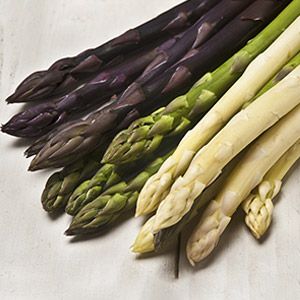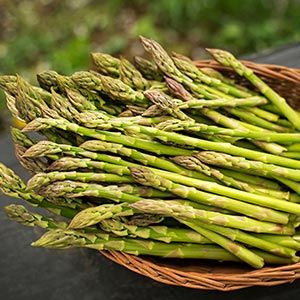Asparagus: This Slender Veggie Is Good for Your Pet’s Gut
A quintessential spring vegetable, this tasty green spear offers prebiotics for a healthy microbiome, as well as antioxidants for better defense against diseases. Find out how to offer it to your pet.

STORY AT-A-GLANCE
- The slender spears that we’ve come to know as asparagus are actually the young shoots of the asparagus plant
- Asparagus is one of the few foods that naturally contain glutathione, a master internal antioxidant and detoxifier
- Asparagus is rich in inulin, a type of prebiotic fiber that helps improve digestive health, regulate blood sugar levels and aids in weight loss
- To choose fresh asparagus, look for spears that are firm, straight and smooth, with tightly closed tips
Editor's Note: This article is a reprint. It was originally published May 28, 2023.
One of the most popular spring vegetables, asparagus (Asparagus officinalis) is easily recognizable for its long, slender, pointy spears. Commonly roasted, steamed or grilled, and prized for its earthy bitter and subtle sweet taste, asparagus can be served on its own or as a side dish for meats or fish. You can also add it to pasta, salads, soups and stir-fries.1
If your pet shows interest in this vegetable, can you indulge them with a bite or two? The answer is yes — asparagus is safe for pets, and it can be a healthy part of their nutritionally balanced, species-appropriate diet. Continue reading to learn more about the benefits of this vegetable to animal companions.
What Is Asparagus?
The spears that we’ve come to know as asparagus are actually the young shoots of the asparagus plant, an herbaceous perennial that belongs to the lily family. The spears are harvested when they’re around 7 to 9 inches long and are green in color.2 Asparagus are also available in purple and white varieties, but these are less common in the U.S.3 Aside from the difference in color, white and purple asparagus also have a milder taste than their green counterpart.4
Asparagus is easy to prepare and can be eaten raw or cooked. Growing asparagus is another story, though, as it takes three years before farmers can harvest their first yield. Once harvesting begins, asparagus must be picked by hand every day so they don’t grow into inedible ferns. This laborious process is the reason why asparagus is more expensive than other vegetables.5
Did You Know?

The early Romans, Greeks and Egyptians were the first to cultivate asparagus. Roman emperor Caesar Augustus was such an asparagus connoisseur that he had dedicated ships to import the best asparagus to Rome, and created the Latin saying “velocius quam asparagi conquantur,” which means “faster than cooking asparagus.”6,7
Asparagus Naturally Contains This Master Antioxidant
“Asparagus is one of the few foods that naturally contain glutathione, a master internal antioxidant and detoxifier.”
This powerful compound directly protects cells from damage through various mechanisms of action, including scavenging diverse free radicals, regenerating antioxidant vitamins C and E, acting as a cofactor for antioxidant enzymes, regulating cellular apoptosis and proliferation, and supporting mitochondrial function, among others.8
Glutathione also plays a critical role in protecting brain health. Low levels of it have been linked to increased risk of neurodegenerative diseases in both humans and animals.9 Moreover, a study published in the American Journal of Veterinary Research demonstrated the vital role of glutathione in the liver health of dogs and cats. The researchers implicated low glutathione levels in necro-inflammatory liver disorders, extrahepatic bile duct occlusion and feline hepatic lipidosis.10
Prebiotics in Asparagus May Help Build Your Pet’s Microbiome
Whole foods are the best sources of prebiotics, which are largely made up of indigestible fibers that feed the beneficial microorganisms in your pet’s gut. Asparagus is particularly rich in inulin, a type of prebiotic fiber that’s been shown to help improve digestive health, regulate blood sugar levels and aid in weight loss.11
Increased inulin intake has also been linked to a dramatic increase in A. muciniphila bacterium in the gut. This bacterial species has been gaining recognition in the pet community for its potential to protect the gut’s mucosal lining, support overall gastrointestinal health and reduce the risk of obesity and inflammatory bowel syndrome (IBS) in animals.12,13
Asparagus Fun Fact

Have you heard of “asparagus pee”? This refers to the pungent-smelling pee that occurs as a result of eating asparagus. It’s caused by asparagusic acid, a compound that produces several sulfurous byproducts, which evaporate immediately and cause urine to be smelly.14 Feeding your pet asparagus can also give them stinky urine, but this is not a cause for concern.15
Other Important Compounds Found in Asparagus
Asparagus provides more than just glutathione and prebiotics — it’s also a good source of phytochemicals and nutrients that may positively affect your pet’s well-being. According to a study in the Journal of Functional Foods:
“Asparagus contains various phytochemical compounds such as polysaccharides, polyphenols, anthocyanins and saponins, which exhibit anti-cancer, anti-tumor, antioxidant, immunomodulatory, hypoglycemic, anti-hypertensive and anti-epileptic effects through in vitro and in vivo experiments.”
Its polyphenolic content, in particular, is made up of 14 types of phenolic compounds, with rutin being the most predominant.16 Research has shown that rutin exerts neurodegenerative, anti-inflammatory, antidiabetic, antitumor, antihypertensive and antioxidative properties.17
In terms of vitamins, it’s a good source of beta-carotene (pro-vitamin A) and vitamins C and E, all of which have antioxidative actions.18 It’s also rich in folate,19 which is vital for creating new and healthy DNA.20
How to Choose Asparagus and Serve It to Your Pet
Buying the freshest asparagus possible is important, because this vegetable quickly loses flavor and becomes woody in texture when it’s been in storage for too long. To choose fresh asparagus, look for spears that are firm, straight and smooth, with tightly closed tips. It should also have a vibrant green hue with white at the bottom, and it should be standing upright in a shallow bin filled with a small amount of water or lined with a damp pad to avoid drying out.21
Avoid stalks that are limp, dull green or have wrinkles, as these are indications of old age. If the asparagus is not standing in water or a damp pad, check if its bottom is dried out and flaky. Look for spears that have moisture in their base but aren’t soft and mushy. When preparing the stalks, wash them right before using them.22
You can serve asparagus to your pet raw and sliced into small pieces — they make for great training treats or interactive toy stuffers. You can also steam asparagus, puree it, then add it to your pet’s food bowl or smear it on a lick mat as a microbiome-building topper. Remember that healthy extras like this should only make up less than 10% of your pet’s daily caloric intake.
Who Are the Top Producers of Asparagus?

China leads the world’s asparagus production by a mile, producing approximately 7.3 million metric tons of asparagus in 2021. Peru ranked second, producing 365,123 metric tons, while Mexico took third place with 328,990 metric tons.23 The U.S. ranked No. 7, with Michigan producing the most asparagus, followed by Washington, California and New Jersey.24

Is Asparagus a Sustainable Crop?
Asparagus ranks No. 7 in the Environmental Working Group’s Clean 15™, which means that this vegetable generally has low pesticide loads, even in conventionally grown varieties.25 According to FoodPrint, asparagus also does not require too much water to grow, so its water footprint is minimal.26 But even though its farming has no significant impact to the air, water, land and soil, there are still reports that asparagus results in high greenhouse gas emissions.
The problem actually lies in how asparagus is being exported to different countries so it can be eaten year-round even when it’s out-of-season. Because the quality of asparagus quickly deteriorates after it’s been harvested, it has to be shipped by air. Air-freighting food creates high amounts of greenhouse gas emissions.27,28
With that said, it’s best to buy asparagus from your local farmers market whenever possible. That way, you can be sure that the produce you’re buying is organic and spray-free, and at the same time locally sourced, so it has lower transportation emissions.
Sources and References
- 1,4 The Spruce Eats, December 29, 2022
- 2 PennState Extension, Asparagus Production
- 3 The Spruce Eats, November 17, 2022
- 5,21,22 The Spruce Eats, October 23, 2019
- 6 NYTimes, Asparagus Rising, April 23, 1995
- 7,26 FoodPrint, Asparagus
- 8 Integr Med (Encinitas). 2014 Feb; 13(1): 8–12
- 9 Eur J Biochem. 2000 Aug;267(16):4904-11
- 10 Am J Vet Res. 2002 Aug;63(8):1187-97
- 11 Diabetol Metab Syndr. 2021; 13: 150
- 12 Vet. Sci. 2020, 7(2), 44
- 13 Am J Vet Res. 2018 Aug;79(8):884-892
- 14 Cleveland Clinic, February 22, 2021
- 15 American Kennel Club, August 19, 2022
- 16 Journal of Functional Foods. Volume 65, February 2020, 103727
- 17 EXCLI J. 2015; 14: 59–63
- 18 Live Science, February 6, 2018
- 19 Unity Point Health, 18 Foods Filled With Folate Every Woman Should Know
- 20 VCA Hospitals, Folic Acid
- 23 Statista, Global leading asparagus producing countries in 2021
- 24 AgMRC, Asparagus
- 25 EWG, Clean 15™
- 27 Hong Kong Free Press, March 31, 2020
- 28 CNN, May 15, 2017











